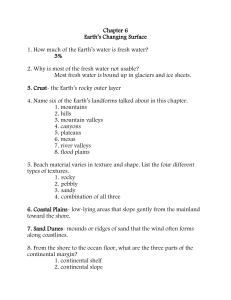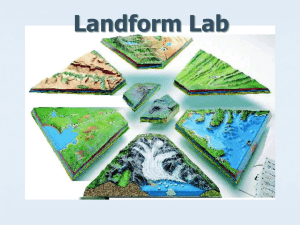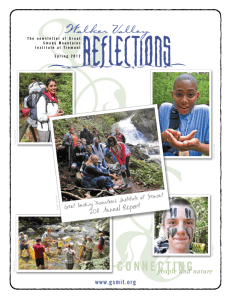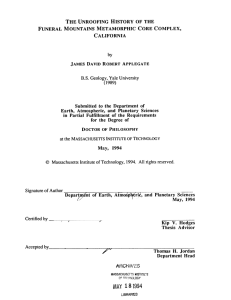Review_Questions
advertisement
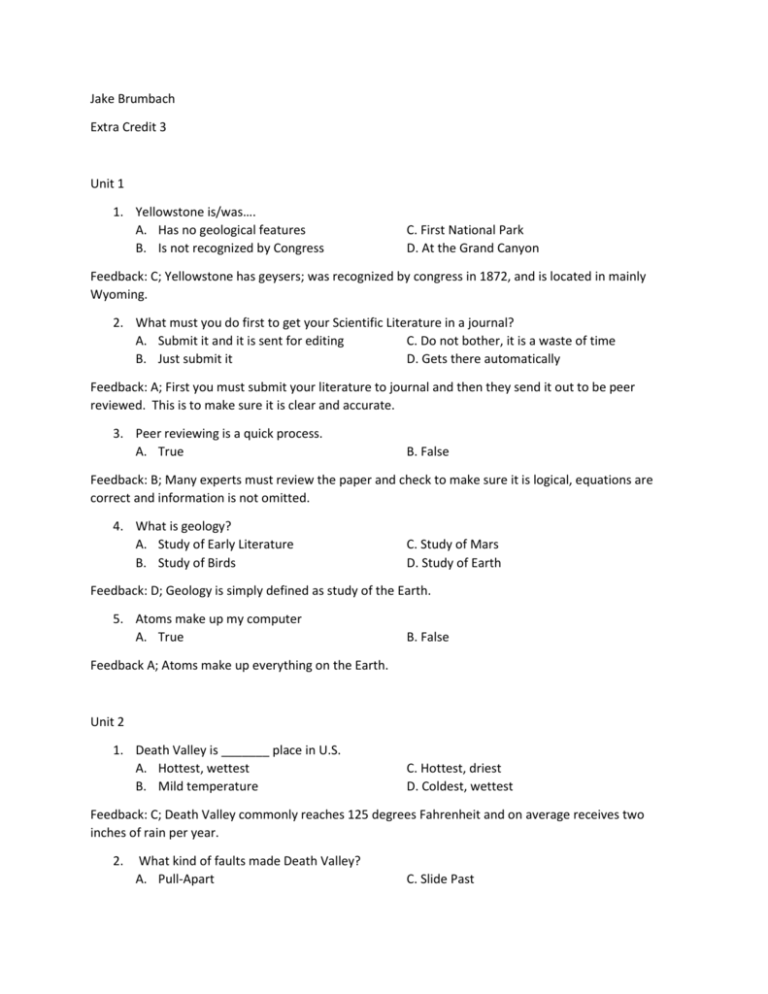
Jake Brumbach Extra Credit 3 Unit 1 1. Yellowstone is/was…. A. Has no geological features B. Is not recognized by Congress C. First National Park D. At the Grand Canyon Feedback: C; Yellowstone has geysers; was recognized by congress in 1872, and is located in mainly Wyoming. 2. What must you do first to get your Scientific Literature in a journal? A. Submit it and it is sent for editing C. Do not bother, it is a waste of time B. Just submit it D. Gets there automatically Feedback: A; First you must submit your literature to journal and then they send it out to be peer reviewed. This is to make sure it is clear and accurate. 3. Peer reviewing is a quick process. A. True B. False Feedback: B; Many experts must review the paper and check to make sure it is logical, equations are correct and information is not omitted. 4. What is geology? A. Study of Early Literature B. Study of Birds C. Study of Mars D. Study of Earth Feedback: D; Geology is simply defined as study of the Earth. 5. Atoms make up my computer A. True B. False Feedback A; Atoms make up everything on the Earth. Unit 2 1. Death Valley is _______ place in U.S. A. Hottest, wettest B. Mild temperature C. Hottest, driest D. Coldest, wettest Feedback: C; Death Valley commonly reaches 125 degrees Fahrenheit and on average receives two inches of rain per year. 2. What kind of faults made Death Valley? A. Pull-Apart C. Slide Past B. Push Together D. None of the Above Feedback: A; The fault Death Valley is on is moving away from each other, causing Death Valley to shrink down into the Earth. 3. How is heat moved around the Earth? A. Radiation B. Conduction C. Convection D. All the above Feedback: D; Radiation is when you can feel when you put your hand near the stove. Conduction is the connection of how everything is transported to an object like a pot on a stove. Convection when you move the food to the dinner table. 4. Earthquakes occur when rocks are moving past other rocks A. True B. False Feedback: A; The breaks are usually angled and not vertical so the rocks collide as they pass by each other. 5. Which magnitude is likely to cause more damage a magnitude 3 or 7? A. Magnitude 3 C. Magnitude 7 B. Same likelihood D. Neither will cause damage. Feedback B; because a magnitude 7 will shake the Earth 10,000 times more than a magnitude 3. Unit 3 1. Crater Lake was formed by? A. A glacier B. Volcanic Eruption C. Rain D. It has always been there Feedback: C; It was created when Mt. Mazama erupted 6600 years ago. The eruption put 200-300 feet thick on the sides of the volcano. Crater Lake then formed from this. 2. What is the lithosphere broken into? A. Plates B. Just air C. The core of the Earth D. Rain Feedback: A; In the lithosphere 8 big plates floating around. 3. Mount Saint Helens has never erupted. A. True B. False Feedback: B; Mount Saint Helens erupted in 1980. This eruption was very traumatic to the area. 4. Where do volcanoes occur? A. Pull Apart Margins B. Hot Spots C. Push-Together Subduction Zones D. All the Above Feedback: D; At pull apart margins there are volcanos that erupt silica basalt. Hot spots make volcanoes like a lava lamp and push-together subduction zones also make higher-silica volcanoes. 5. What is are tsunamis? A. A Large tornado B. A low wave that moves very quickly C. The act of lava flowing out of the volcano D. A rain cloud that rains meatballs Feedback: B; Tsunamis is a low wave that moves very quickly and when it gets near shore it changes into a short, steep wave. These huge waves can very traumatic to any area it hits. Unit 4 1. The Great Smoky Mountains are the most visited national park. A. True B. False Feedback: A; The Great Smoky Mountains had 9.7 million tourist in 2012. This is more than doubling the closest competitor, the Grand Canyon who respectably had 4.4 million in the same year. 2. What feature do the Great Smoky Mountains have? A. Volcanos C. The older rocks sit on top of younger rocks. B. Has geysers D. Highest point in the United States. Feedback: C; The older rocks sit on top of the mountains. This is because of the push-together boundaries that they sit on. The rocks act much like if you would push a piece of paper together. 3. What kind of structural style are the Great Smoky Mountains on? A. Pull-Apart C. Push-together B. Slide Past D. Run into each other Feedback: B; The Great Smoky Mountains are on a slide past structural style. They were built because of obduction. This obduction most likely occurred from the ocean crust and continental crust colliding. 4. In the past big glaciers left ___________ in the Rocky Mountains and surrounding areas. A. Lake C. Moraines B. Geysers D. Both A and C are correct Feedback: D; Large glaciers made the ground sink from their great weight and then when they melted all of the water piled up and made a lake. And the moraines are sediment and such left behind from a glacier, which is how we know glaciers were there in the past. 6. One reason tsunamis are very devastating to people are… A. Water often goes out as more is coming in C. Tsunamis are only for surfers B. The lava moves very quickly D. All of the above Feedback: A; As the front of the water comes in and makes contact with the land, it will start to go back out to sea, while more water is coming back in. This makes the depth of the water even greater. Also the water is usually moving too quickly for someone to run. Unit 5 1. Why does the equator get more sun than the poles? A. The poles get more sun C. Because of simple geometry B. The sun likes the equator more D. Every place gets the same amount of sun Feedback: C; The equator gets more sun because the sun signs straight at the Earth. Since the Earth is a sphere it has a smaller area at the poles for the sun to go through. 2. Which of the following are some examples of erosion agents? A. Mass Wasting C. Glaciers B. Running water D. All the above Feedback: D; All of these agents help make erosion happen. Some others are wind, ocean waves, and ground water. 3. What are landslides driven by? A. Gravity B. Cold C. Heat D. Tectonic Plates Feedback: A; Landslides can happen very fast or very slow. For example if you put a bunch of individual rocks on top of each they will fall pretty quickly in the beginning but as the pile gets lower it will take longer. 4. For big rocks to turn into smaller ones they need to be turned into smaller rocks and this is known as chemical weathering A. True B. False Feedback: B; This is known as mechanical weathering and this happens through, growing things in cracks expanding and shrinking of during changes of heat, and a few other ways. 5. Why do rocks break when water freezes in inside of a crack? A. When water freezes it expands. C. The water dissolves it B. It is too cold for the rock D. All the above Feedback: A; It is common knowledge that when you freeze water it becomes stronger and expands. When this happen inside a rock it pushes the rock apart and it will break.



